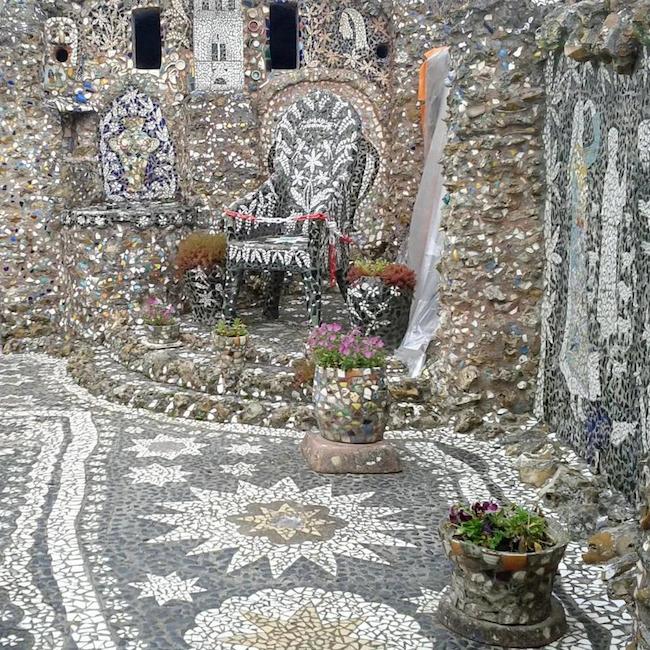I envy outsider artists. I envy their ability to be so wholly consumed with a project that they’re able to pursue it while ignoring convenience, comfort, the approval of their friends and families (let alone critics), and their own mortality. Continuing long after most normals would have given up in favor of some other stimulus, these artists produce works of such a scale that your jaw flops down to your chest when you see it for the first time. If their work personifies some kind of mental disorder, then I’d gladly trade my sanity for it. Yes, I’d probably ruin all of my personal relationships along with my health but I’d get so much done.
As the story goes, Raymond Isidore was a mild-mannered cemetery worker in Chartres, France. One day, around 1938, he was walking through a field when he saw something glinting near his feet. It was a tiny shard of glass. He began collecting pieces of glass, crockery and porcelain and returned with them to his home. He started to decorate a wall of his house with a mosaic created from the shards he found.
The mosaic on that wall metastasized, spilling over to other walls, and the ceiling, and the facade, and the stove, and the furniture. Shards, more than 15 tons of them over the course of the project, piled up in the garden outside. Children must have been turned out of their beds as their dad fled his horror vacui by cementing shards all over their headboards. According to Chartres’ tourism site, the neighbors started calling Isidore “Picassiette,” meaning someone who steals (pique) plates (assiette). Over time that nickname evolved into a nicer one, Picasso Assiette, but the former name stuck and today the home is known as Maison Picassiette.
God, who must love outsiders like Isidore for as often as he shows up in their work, makes appearances throughout the home. Isidore built a chapel in his back yard over the course of three years. Mosaics that mimic the windows at Chartres Cathedral decorate the walls. More than that, there’s the city of Jerusalem rendered in mosaic. He also built a room, mostly in blue, with the tantalizing title of “Spirit’s Tomb.” Who, or what, was talking the cemetery worker as he was building these things?


Isidore finished the home after nearly 30 years of work. He died in 1968, just two years after he finished, close enough to make me wonder to what extent goals of enormous scale, aimless though they may seem at the time, can keep people alive.
The home is open to tours on a seasonal basis. You can find out more information on that here. If you’d like to explore the home from your computer, we suggest that you visit this mosaic web site.
Bill Rodgers is the Managing Editor of cfile.daily.
What do you think of Isidore’s three-decade descent into contemporary ceramic art? Let us know in the comments.









The term “Magnificent Obsession” comes to mind when thinking about Isidore or any number of outsider artists who create large scale environments – homes, “grottos”, road side attractions. Your coverage artists like Isidore and Nek Chand is much appreciated; I have shared this post on the Mosaic Art NOW Facebook Page. BTW, Isidore continues to inspire locally through the work of “Chartres, les 3R” – an organization that produces excellent international contemporary mosaic expositions and teaches the making and restoration of mosaic. More info on them here: http://www.chartres-mosaique-les3r.com/ Thanks again.
I’m thinking, all this took only thirty years???
I wonder what kind of toll that work takes, not only for the guy doing it but also for the people around him. It’s probably not fair to assume the worst, but there has to be an impact.